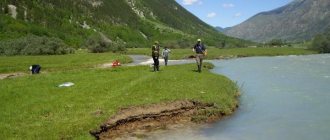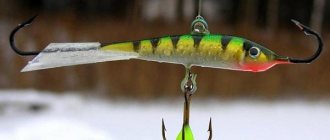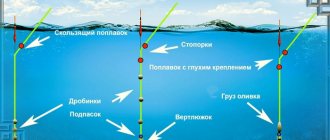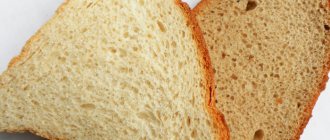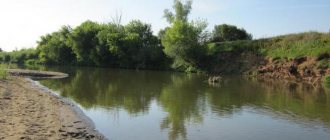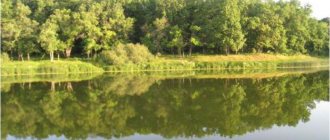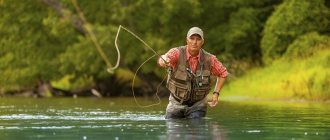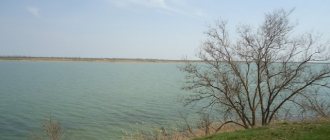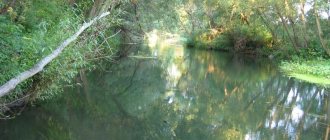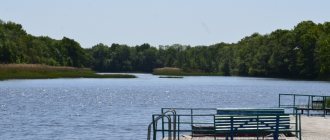Chub wintering areas
The freshwater chub from the carp family is a semi-predatory fish with an omnivorous diet.
Its diet includes arrow leaves, plant stems, and small fish, crustaceans, tadpoles, as well as mice and small birds. Often the chub lives in small rivers with a bottom of sand or stones, with a fast current. The fish lives in a school at a depth of no more than 6 meters.
In winter, the chub becomes inactive, but during the first and last ice it comes out to feed. In winter, it swims near the bottom, on sunny days, reaching the middle and upper layers of water. Its food is small fish such as roach, bleak and fry of its class. Preferred places of streams with eddies that attract fry, which are desirable prey for this semi-predator.
During a thaw on the last ice, chub are often found near shallow sections of the river. Due to the increase in water temperature, it rises from the pits. When looking for a place to bite, you should pay attention to the predominance of underwater debris, rocky ridges, old bridges, and fallen trees. It must be remembered that the fish chooses its trajectory based on its vision and is not attracted to dark areas under the ice.
Typical chub sites on a microriver
In July and August, on the micro rivers where I fish (and these are the Iznair, Kiestendeyka, Arkadachka and Biryuchka), aquatic vegetation grows. Algae during this period constitute the main diet of the chub, but this does not mean that the fish completely refuses insects, worms and caddisfly larvae falling into the water. Moreover, in juvenile chubs, predatory instincts are not as pronounced as in their older counterparts.
Large individuals are infrequent visitors to shallow water; they prefer riffles, washed-out banks, deep holes and pools. Now let's talk in more detail about each of these places.
Microroll. It would be incorrect to use the term “riffle” in relation to my micro-rivers, because by “riffle” we mean “a strong current and a vast shallow area with rocky or sandy deposits.” For a micro-river, the word “micro-riffle” is better suited.
It's almost the same thing, but not on such a large scale. The chub comes to the micro-riffle closer to noon. In the morning hours it is better to pay attention to other places. In this area, I most often use medium-depth cranks and heavy-core spinners.
Pool. It is in the pools that you can catch the largest chubs. Usually at the bottom of the pools there are snags - a real home for the redfin. In the morning hours, the fish hides in these snags, and closer to lunch they rise to the surface.
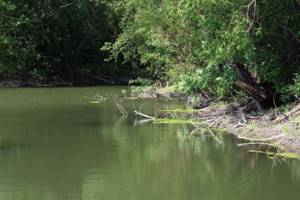
Until the chub reaches the surface, it can be caught using a deep-diving wobbler, but when the sun begins to burn, the bighead loses activity and stands motionless at the surface. In this case, you will not be able to seduce the fish, no matter what tricks you resort to. There is an option to use a small walker, but the effectiveness of such an idea is 50/50.
Pit. Chub are found in the pits both in the morning and at lunchtime. That's why I think this place is the most versatile. Closer to lunch, the chub leaves the pit, and it is important for him to control what happens at the exit from it. Most often, when fishing in pits, I use “micro-oscillators” weighing 2 - 2.5 g and small walkers: in the morning, spinners work great, and when the chub comes out of the pit, it is easier to catch it with a surface bait that imitates an insect that has fallen into the water.
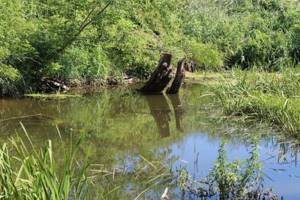
A washed-out bank with overhanging branches. This is a classic chub spot. And even if you didn’t manage to catch a big-headed fish here, don’t doubt that it is here. Most likely, you are doing something wrong. It is very important to move the bait parallel to the washed-out bank. And this is where you need casting accuracy.
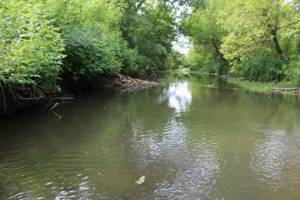
Gear selection
When winter fishing on currents and ice-free river sections, you can use summer gear: spinning rod, feeder, float rod.
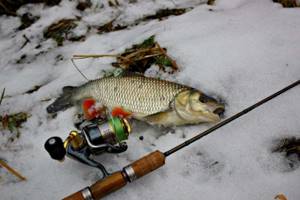
On ice, a winter float rod with a variety of baits is used.
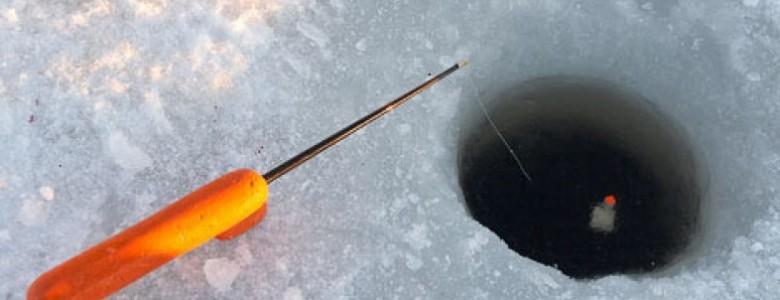
For winter fishing, an ultralight type spinning rod with a dough weight of up to 10 grams is suitable. The optimal rod length is up to 3 meters with a medium action.
When fishing from ice, we recommend using a lavsan nod
When choosing a nod for a spinning rod, you need to take into account its rigidity. A nod made of lavsan, an elastic and durable material that is insensitive to temperature changes, has proven itself well. A stainless steel metal nod would be an excellent choice because of the good signal about the bite and the transfer of low temperatures and the absence of deflections under the influence of the current. The cone shape of the guard helps disperse the sensitivity towards the end of the metal plate from which it is made.
The water movement during the game practically does not affect the tackle itself, but slightly lifts and moves the bait itself, which the chub grabs and pulls the guard downwards. On the lower part of the rod, it is necessary to place the sinker above the hook with the leader.
Equipment in the form of a 0.18 mm main line, a sliding shot, an “olive” and a 0.14 mm leader with a hook number 3.5. The color of the fishing line should be chosen not bright, since the chub has well-developed eyesight, and bright colors can scare it away.
Diagram of a float rod for winter fishing
Suitable baits for spinning are wobblers with minimal movement - minnows and shads. Among silicone baits, choose worm-type twisters and inert slugs. The bait should appear sharply and next to the chub, while the wiring is carried out to drift in the transverse movement of the current or against the current.
Pontoon 21 Red Rag Jackall Chubby Smith Camion SR Yo-Zuri Hardcore Yo-Zuri L-Minnow
It is best when the bait appears unexpectedly in the chub’s field of view and passes as close to it as possible. The correct option for winter wiring would be drifting across the current or upstream.
Fishing on ice-free small rivers
Winter feeder is possible on non-freezing rivers.
Use bloodworms as bait. And in bait, use more animal components. Small rivers are attractive because they do not freeze in winter, and chub continue to be caught with most popular summer gear.
- Using a feeder with a rod up to 3.5 meters, dough up to 110 grams, and a heavy feeder ensures stability in the current.
The use of feeders of different weights from 50 to 120 grams is explained by different power flows. A plastic or mesh basket with a metal strip ensures a stable position at the bottom and quick lifting when pulled out. The reel should have a supply of strong, soft fishing line with a diameter of 0.18 mm, which helps to pull out any large catch. The diameter of the gatehouse depends on fishing activity and ranges from 0.08 to 0.11 mm, and up to 80 cm long and with a hook number 10. Winter baits. The easiest way to catch a chub in winter is with meat baits such as chicken liver, maggots, and meat loaf. - Fishing with a summer float rod in winter it is possible only in open reservoirs from the shore. The length of the rod is no more than two and a half meters, the thickness of the fishing line is up to 0.35 mm, the leash is 0.20 thick and no more than 70 cm long. Choose a large hook No. 8-9. The float is attached at least 0.9 meters from the hook, which is best secured to the fishing line using electrical tape at its base and top. This technique will reduce the slipping of the fishing line when the nozzle is immersed. As bait, you should use meat mixtures seasoned with purchased aromatic drops; vegetable baits have little attraction for chub in winter.

Diagram of a float rod for fishing from the shore - When fishing on ice They use more fishing rods made of foam plastic or corks, which do not allow their hands to freeze. Lures include jigs, spoons and balancers. Winter fishing line is thin - up to 0.14 mm, frost-resistant, of medium hardness and reduced elasticity. Line volume up to 20 meters. The fishing rod must be resistant to sub-zero temperatures. The use of “filly” tackle is due to its strength and reliability. The function of the sinker is performed by small lead or tin pieces of pellets, which are installed above 15 cm from the hook. You need to choose a hook that is thin-wire and sharp. The size of the hook must correspond to the bait: bloodworms require size No. 2-3, piece bait No. 5-7, fry up to number 10. A foam gray or brown barrel-shaped float should be selected in accordance with the depth and strength of the current so as not to scare away the wary chub. Worms are suitable for bait; it is better to plant them in bunches, maggots, bloodworms and bread.
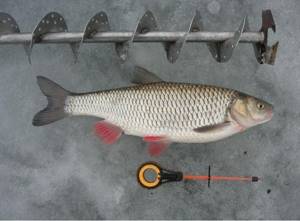
What is the best time of year to fish?
Catching chub with a spinning rod is quite an exciting activity, requiring not only skills, but also knowledge of seasonal characteristics. For each season, it is necessary to carefully select spinning rods, equipment, bait, as well as the use of different fishing techniques.
Fish behavior may vary depending on the following factors:
- water temperature;
- transparency and turbidity of the aquatic environment;
- degree of algae overgrowth.
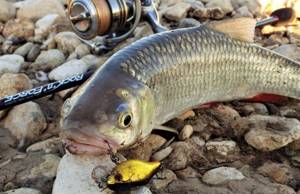
The first active chub bite can be observed from the beginning of spring, with the disappearance of ice from the rivers. But larger bites begin after consistently warm weather sets in, usually the last week of March. At this time, representatives of the species prefer to be on a rocky bottom, the depth of which is usually from 1.5 to 3 meters.
To catch chub in the spring months, it is better to use the following gear and equipment:
- bottom fishing rod;
- sliding sinker, leash up to 40 cm, hook with a long shank;
- attachments: chicken or beef liver;
- landing net
Active biting can please you in the morning and daytime, but in the evening the activity of the chub noticeably declines . In the spring, the fish is distinguished by its sharp behavior, the bite is very bright, it takes the bait sharply and confidently.
We advise you to learn about the features of chub fishing in winter.
Starting from April, the use of earthworms and dung worms as bait is effective. You can also achieve a good bite by using crayfish or small minnows. If you want to catch a chub with a jig, you should choose drop-shaped tackle weighing up to fifteen grams. A bloodworm or maggot is placed on the hook.
From the beginning of May you can expect a good bite using a bottom or fly fishing rod . An effective bait is the cockchafer. At this time, the chub rises higher and becomes active at the surface of the water. The time has come to use a Bolognese rod with a barrel-shaped float.
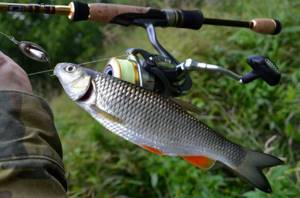
By the time summer arrives, it is worth noting the rather active behavior of representatives of the species. The most successful places for fishing are areas with strong currents and river rapids with rushing water . The fish leave the quiet silty pools that the current bypasses. In the summer, the chub does not starve, since the choice of food supply is quite wide, so anglers most often catch it on artificial insects. Fishing rods are taken fly or spinning. If you want to pull out fish with a float tackle, the grasshopper has proven itself very well as bait.
Starting in July, you can already start working with bait . It is used as steamed bread, steamed barley with the addition of boiled eggs or liver. September is characterized by the fact that the food supply of the chub, which previously consisted of insects and larvae, is now presented in the form of fry. In October and November, this type of feeding becomes the main one and these freshwater animals switch to a predatory lifestyle. You can expect a good bite on warm sunny days using spinning rods, wired fishing rods or a fly rod . Small rudd and roach are used as bait.
Did you know? The chub is the only fish with a pronounced predilection for berries and fruits. This red-finned predator happily eats grapes, cherries, blackberries, etc.
Winter fishing on ice-free rivers is also exciting. The bite can be expected in the areas where the chub is located. Usually these are quiet underwater places near shelters, where the chub feeds on invertebrates, crustaceans and small fish at the bottom. Bait is not used in winter. Bait of plant origin is irrelevant in the cold season . Chub are caught using a jig.
Particular attention should be paid to the thickness of the fishing line, since the fish behaves very carefully and will not take the bait if it sees the tackle in clear water. The chub is most active during the period of first ice . It occupies shallow places with little current. The equipment used is float and nod fishing rods for winter fishing, and bloodworms or worms are good for bait.
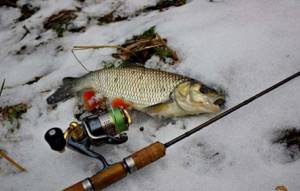
Bait for chub in winter
For fishing on a float or feeder without the use of live bait or with them, complementary foods play an important function in attracting fish.
Use bait that helps hold the fish for a long time. Feed in the same place for a week.
By adding additives with certain aromas and tastes to the water at the same time, you can train the “lobato” to swim as scheduled. Groundbait can be made from:
- steamed peas;
- pearl barley and oatmeal;
- makukha;
- of bread;
- cake.
In winter, the meaty taste and aroma of maggots. Bloodworms and worms will be very attractive to a hungry chub.
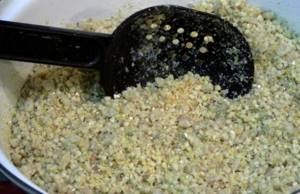
The food element can be live bait - the baked blood of any animal. A gauze rag or foam rubber is impregnated with it and tied to any heavy object that should be thrown while fishing. It should be remembered that when using worms, beetles, peas, and larvae, blood soaking is not suitable as bait. The use of these baits is combined with various cereals and special commercial compositions for fish.

Choose small live bait – the maximum size is shown in the photo.
Mixing store-bought and home-made bait will enhance the effect of attracting chub. For feeder fishing, it is better to hammer the bait mixture into the feeder and make up to 10 sharp casts to create a food table for a representative of the cyprinids. When using a summer float rod, you can throw molded lumps of feed mixture into the desired place.
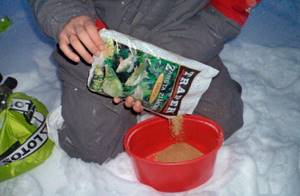
Store-bought bait Traper, Sensas and Dunaev are perfect for winter fishing
Feeding chub for ice fishing is a little different from fishing with summer gear. The fishing area is fed with various mixtures, always with the addition of bloodworms. Throwing bait into the hole from which chub fishing will be carried out is not carried out. You need to drill an additional hole at a short distance from the main hole and carefully throw the bait to the bottom. A useful tip is to use two feeders, one of which is left open, and the food from the other is washed out slowly.
Two ways to fish from ice
Catching chub on ice can be done using two types of winter bait - a jig and a spinner.
For the spinner
Fishing for chub requires the selection of small spinners of a white or silver shade, no more than 4 cm in length; when fishing for fish in the current, it is most appropriate to choose gliding spinners that help provoke and provoke the chub to bite. The lure mechanism is simple: after jerking the fishing rod, the lure should jump 0.3 meters in the water and sharply return to its previous position. You must wait two seconds after the jerk.
On the jig
Catchers for chub - ant, bug, uralka
The choice of fishing line diameter should be no more than 0.17 mm; a thicker fishing line reduces the frequency of bites by the distrustful chub.
Used: uralka jigs, ant, oatmeal, shot, cone, droplet. But more often it bites on a classic shot with a diameter of 6–8 mm, with meat bait such as bark beetle, maggot, bloodworm on hook No. 5-6. To make jigs more attractive, yellow and white cambrics no larger than 3 mm are attached, the color of the bait itself or a natural metallic shade or black.
The game with the jig begins at the base of the bottom and with repeated swaying movements, pull the jig 0.3 meters above the bottom. If the fish is not interested, make a sharp swing of the jig down and up and repeat the game.
Lures for catching chub on small rivers

Of course, each of us has our own places and preferences in fishing. My favorite chub spots are on small rivers, where rapid riffles alternate with quiet whirlpools, and dense branches of coastal bushes and trees hang over the water. There is the widest choice for the use of tackle, bait, and methods of presentation. In addition, this is very dynamic fishing, in which you have to move a lot, somewhere along the shore, somewhere along the wade. At the same time, we constantly need to camouflage ourselves, using folds of the terrain and coastal vegetation, in order to fall into the field of view of our underwater big-faced counterpart as little as possible.
When fishing for chub, camouflage is required
I have nothing against bright fishing suits, but to catch the cunning and cautious chub I prefer to wear a camouflage hunting suit. Over his jacket or shirt in the summer, I put on an olive-colored fly fishing vest. It's much more convenient with him. Firstly , there are many pockets for boxes with bait, and secondly , the fly fishing vest has special loops made of plastic or metal - one on the back under the collar and two on the sides, which are needed for attaching a compact landing net, again a fly fishing net. It is always literally at hand, can be easily and quickly removed and hung back in place thanks to the magnetic clasp - and you won’t miss the fish, and you won’t have to frantically grab it with your hand. For a photo shoot, we carefully remove the trophy from the net, take a photo and quickly release it. During the transitions, the landing net on the back does not cling to the branches and does not interfere at all, I practically do not notice it. In general, this is a very useful attribute specifically for chub fishing.
If the main chub sites on the river are familiar to us, then, observing maximum caution, silence and literally bending down, we go to the next point. This is not a joke or a game of Cossack robbers, just good camouflage on this fishing trip is the key to success. Although it also happens that the chub is so active and vigorous that it is caught literally under your feet. However, this is an exception, which you should not count on; it is better to play it safe and pay attention to camouflage.
